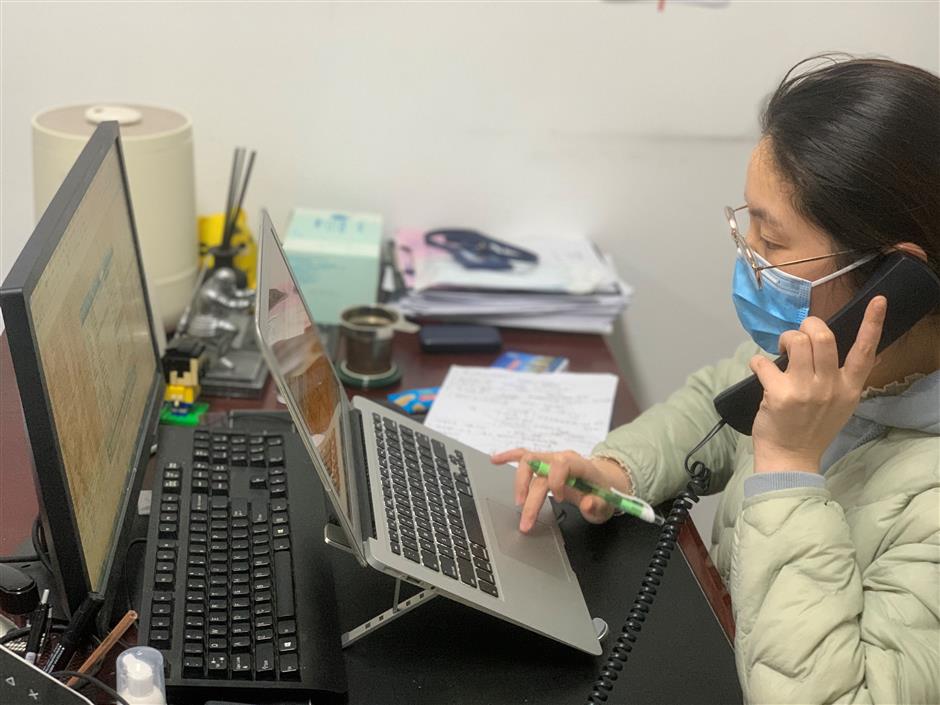Grassroots worker creates flow chart for medical crises
In the Pudong New Area, a young grassroots government worker came up with a flow chart and a detailed table to help people understand how the pandemic-related protocol in the area is changing quickly.
These graphics were created by Wang Xueying, a college graduate chosen to work in the grassroots government system, as part of preparations for greater responsibility in the future.
Wang, who is in her 20s, was working in Pudong's Zhoupu Town.
The flow chart is a simple guide for locked-down patients in need of hospital visits for hemodialysis. It includes important information that can be helpful to both patients and community workers.

Wang Xueying at her busy office desk in Pudong's Zhoupu Town.
Zhoupu's Center for Disease Control & Prevention has recruited a number of young government staff to help control and prevent the current pandemic in the city. After completing her MA in Social Work last year, Wang has been active in ensuring medical needs for residents in locked-down communities, and in transferring confirmed cases.
At first, Wang was apprehensive since she was not familiar with the hemodialysis process, but she recognized that hemodialysis was these patients' only hope.
Due to the pandemic, all patients had to make an appointment to schedule hospital visits and closed-loop ambulances. They also needed to show a negative test result within 48 hours.
Every day, Wang receives lots of messages from various WeChat groups. To get acquainted with her entails being able to recognize and sort out a wide range of information quickly. She also sought guidance from her counterparts in other places or from more experienced colleagues.
On a typical day, Wang and her colleagues would field over 100 phone calls. They had to switch to hands-free mode or earphones as their overused phones became too hot. She has prioritized 11 WeChat groups at the top of the list and reads each of the messages carefully.
"No one has handled the transfers of so many hemodialysis patients during a lockdown in our town before, so I had to figure a way out myself," Wang told Shanghai Daily.

Wang's flow chart for transferring hemodialysis patients.
According to Wang, the neighborhood committee normally comprises thousands of residents, and they don't have time to carefully read all the messages during the lockdown. Thus, a clear flow chart is advantageous to avoid repeated and ineffective communication. It also reduces the burden on community workers, which is helpful to patients.
In the notes for patients, Wang also cares about their health and reminds them to carry blankets and snacks just in case the waiting time at hospitals is long.
Wang recalls a patient who was quite nervous because his hemodialysis had been delayed for two days. They had to wait for an appointment despite the requirement for reservations. Wang advised him to take an urgent nucleic acid test that night so that he could be placed on the waiting list once the results were available, which would be in five to eight hours. Because someone on the list failed to show the needed nucleic acid test result, the patient was able to start hemodialysis the next day.
Given the requirement for reservations, they still needed to wait for an appointment. Wang advised him to take an urgent nucleic acid test that night so that he could be placed on the waiting list once the results became available in 5 to 8 hours. Luckily, the patient got his hemodialysis done the next day because someone on the list failed to provide the required nucleic acid test result.
"It was an unusual method, but it worked," Wang said.
Wang, a recent graduate who has been working for over a year, is doing her best to figure out the most efficient method and solution for dealing with a variety of emergencies. She says officials should not be the "extinguisher," but rather should set up a reasonable working mechanism in advance and continuously improve it.
She has instructed community workers to locate all hemodialysis patients in neighborhoods that are locked down. They also need to record patients' basic information, including an assessment of their infectiousness.
While working at the town's CDC, Wang realized that the grass-roots official was a link between hospitals and neighborhoods.
"It is important for us to tackle many issues, regulate our emotions properly and handle stress all the time," Wang said.
Wang believes that the conflicts between patients and community workers are primarily caused by patients' excessive focus on their own lives and health. When they're not feeling well, it is difficult for them to be rational.
"If you sincerely help and solve their problems, they will realize that you are doing your best to help them," Wang said.
In addition to the flow chart, Wang has also made a sheet recording common problems faced by patients and relevant solutions for them.

Wang kept a record of the most prevalent symptoms and difficulties that patients in the community had. She also jotted down her responses to the issues.
Because of the high mobility of grass-roots workers and the increasing number of confirmed cases, Wang has to focus on helping transfer those cases and hand over the medical security work to another colleague. If her colleague has questions, Wang can confidently tell him what to do or whom to ask.
She is waiting for normalcy to return to the city again.
"I haven't worn any protective suits during the pandemic in Shanghai, but I have sat in front of my computer and phone all these days and received countless calls," Wang said. "I believe we will soon win this battle."

















